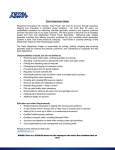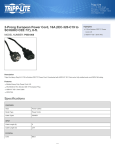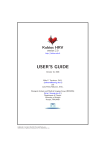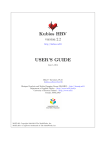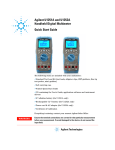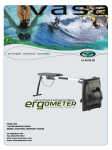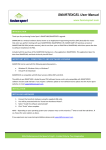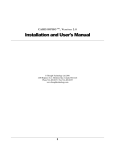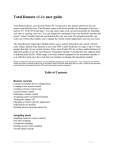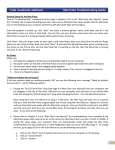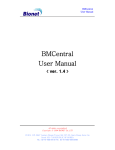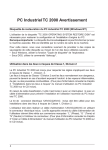Download Smartbeat User Manual
Transcript
USER GUIDE Updated August 2012, App Store Version 1.0.0 © Fusion Sport 2012, All Rights Reserved SMARTBEAT User Guide 2 OVERVIEW Heart Rate Variability (HRV) is an increaingly popular tool for monitoring athlete wellness and recovery. HRV was initially monitored using ECG traces, however in recent years the use of RR intervals that are measured by selected commercially available heart rate monitors has been validated. SMARTBEAT is an experimental development project between Fusion Sport and several of our leading SMARTABASE customers. SMARTBEAT is designed to offer athletes and coaches a flexible method for collecting Heart Rate Variability data and performing a standard set of analysis techniques. The application is not designed to provide recommendations to athletes or coaches, as the field of HRV is still lacking established normative data, and considerable expertise is required by the user in order to make decisions based on the outcomes of the data collected. SMARTBEAT is designed to collect and analyse RR Interval data and perform standard time domain and frequency domain analyses. Functions include: Configurable stabilisation, lying and standing phase lengths Configurable target breathing frequncy Audio prompts for phases and breathing frequency In‐app time domain and frequency domain analyses including SDNN, RMSSD, NN50, pNN50, Mean RR, TotalPower, LF Power, HF Power, LF Normalised Power, HF Normalised Power, Power ratio (LF/HF) Graphical representation of RR interval tachogram, HR plot and Power Density Spectrum Email raw file function HARDWARE REQUIREMENTS SMARTBEAT is compatible with iPhone 3GS, iPhone 4, iPhone 4S, iPod touch (3rd generation), iPod touch (4th generation) and iPad. NOTE – SMARTBEAT requires iOS 5.1 or later, and may suffer performance issues on the iPhone 3GS. SMARTBEAT has been designed using the Wahoo Fitness API (www.wahoofitness.com) and therefore requires the Wahoo Fitness ANT+ dongle for operation. At the time of the release of Version 1.0.0 SMARTBEAT does not support the Wahoo Blue Bluetooth Low Energy strap version, as RR Interval data is not currently supported by the Wahoo Blue HR straps. Please check for updates as this will be implemented in future releases. Other ANT+ heart rate straps are compatible with the Wahoo Fitness dongle and may be used. For a list of compatible devices please visit the Wahoo Fitness website. HARDWARE SETUP INSTRUCTIONS 1. 2. 3. 4. 5. Insert the ANT+ dongle into the 30 pin connector at the bottom of your iOs device Launch the SMARTBEAT application and go to the settings area Ensure the Fisica dongle is connected Fit the heart rate strap to the torso. You may need to wet the electrode areas on the strap to achieve a heart rate signal Go back to the main dashboard screen in SMARTBEAT and request a new connection by pressing the “Click to “connect” box Your device is now ready to use. © Fusion Sport Pty Ltd, 2011, All Rights Reserved SMARTBEAT User Guide 3 SET UP YOUR PROFILE If you wish to use the email or upload to SMARTABASE functions, you will need to enter your details in the “Profile” tab. CONFIGURING YOUR SESSION There are a wide variety of protocols used in the study of HRV. In the “Settings” are, you can configure the following options – 1. 2. Duration of stabilization, lying and standing phases Target breathing frequency for each of these phases Once configured these settings will be saved for future sessions. RUNNING A SESSION IMPORTANT NOTE – It is highly recommended that you enable Airplane Mode on your device prior to using SMARTBEAT, so that you are not interrupted during your session by phone calls, emails or other notifications. If iOS diverts attention away from the application, for instance for an incoming call, or the user presses the home button, the application will exit with a warning and all user data from the current session will be discarded. To turn on Airplane Mode, go to the Settings App on your iOs device. To run a session – 1. 2. 3. 4. Ensure your volume is set to a comfortable level for you to hear the audio prompts during the session Ensure your HR device is connected and working properly. You should see a Heart rate value on the screen Press “Start New Session” to begin. Follow the audio prompts until the session is completed. You will be alerted when the session is finished and can then view your data NOTE – if you wish to run another session, be sure to close the app first and restart it, as this will free up the iOs memory for the following session. © Fusion Sport Pty Ltd, 2011, All Rights Reserved SMARTBEAT User Guide 4 VIEWING AND EXPORTING RESULTS Results can be viewed in the “History” tab. When you tap on a session to open it, you will be presented with the following data – Time domain and frequency domain analyses including SDNN, RMSSD, NN50, pNN50, Mean RR, TotalPower, LF Power, HF Power, LF Normalised Power, HF Normalised Power, Power ratio (LF/HF) Graphical representation of RR interval tachogram, HR plot and Power Density Spectrum EXPORTING RESULTS VIA EMAIL Results can be exported via email in CSV format. The CSV file contains the following data 0 Row 1 – Date Row 2 ‐ SDNN, RMSSD, NN50, pNN50, MeanRR Row 3 ‐ Total Power, Low Freq. Power, Low Freq. Normalised Power, High Freq. Power, High Freq. Normalised Power, Power Ratio (LF/HF) Table 1 ‐ TIME DOMAIN ANALYSIS (4 columns): Beat Number, Total Time, Time Between, and Heart Rate Table 2 ‐ FREQ. DOMAIN ANALYSIS (2 columns): Frequency Axis (Hz), PSD Values To export raw files via email, ensure your email address is set correctly in the settings tab on the dashboard of SMARTBEAT. EXPORTING RESULTS TO SMARTABASE SMARTABASE is a comprehensive Athlete Data Management system that your organization must have purchased and provided you with a login to use. Please note it is not included with the SMARTBEAT application. SMARTBEAT can export results directly to your SMARTABASE account. For details of how to configure your SMARTABASE system to receive SMARTBEAT raw files, please consult your SMARTABASE system administrator or Fusion Sport Account Manager. Once configured, data can be sent to SMARTABASE by‐ 1. 2. Go to the “History” tab in SMARTBEAT, and open the session you wish to export Scroll down and tap the “Upload to SMARTABASE” button TROUBLESHOOTING Problem Possible Cause Solution Heart rate device is not connected Application crashes on save Incompatible hardware Device not connected Heart rate strap is not properly fitted Insufficient memory Check that you have a compatible HR strap on the Wahoo Fitness Website Repeat steps for connecting HR device Wet the electrode surfaces on the strap and ensure it is fitted properly. Ensure your device is running iOs version 5.1 or later Exit SMARTBEAT between sessions Close other applications on your device which may be using memory Heart rate is not displayed © Fusion Sport Pty Ltd, 2011, All Rights Reserved SMARTBEAT User Guide 5 If you require any assistance please contact [email protected]. For further hardware support issues please contact Wahoo Fitness or visit their website support area. REFERENCES AND FURTHER INFORMATION ON HRV K, Fairchild, M. O’Shea, “Heart Rate Characteristics: Physiomarkers for Detection of Late‐Onset Neonatal Sepsis”, Clinics in Perinatology, vol. 37, (3), pp. 581‐598, 2010 University of Eastern Finland, “KubiosHRV”, Biosignal Analysis and Medical Imaging Group, 2012 C. Ieong, “ECG QRS Complex Detection with Programmable Hardware”, Engineering in Medicine and Biology”, pp 2920 ‐ 2923 R. M. Baevskii, “Analysis of Heart Rate Variability in Space Medicine”, Human Physiology, vol. 28, (2), pp. 202‐ R. M. Baevskii, “Heart and Circulation under Space Conditions”, Cor Vasa, vol. 7, (3),pp. 165, 1965 G. Clifford, “Quantifying Errors in Spectral Estimates of HRV Due to Beat Replacement and Resampling”, IEEE Transactions On Biomedical Engineering, vol. 52, (4), 2005 GB. Moody, “Spectral Analysis of Heart Rate Without Resampling”, Havard‐MIT Divison of Health Sciences and Technology. Task Force of the European Society of Cardiology, “HRV: Standards of Measurement, Physiological Interoperation, and Clinical Use”, Circulation, 1996 H.S Song, “The Effects of Specific Respiratory Rates on Heart Rate and Heart Rate Variability”, Applied Psychophysiology and Biofeedback, vol. 28 (1), 2003 Nexus Health Care. (2012). Heart Rate Variability [online]. Available: http://nexuswholehealth.com/heart‐rate‐ variability.php © Fusion Sport Pty Ltd, 2011, All Rights Reserved





